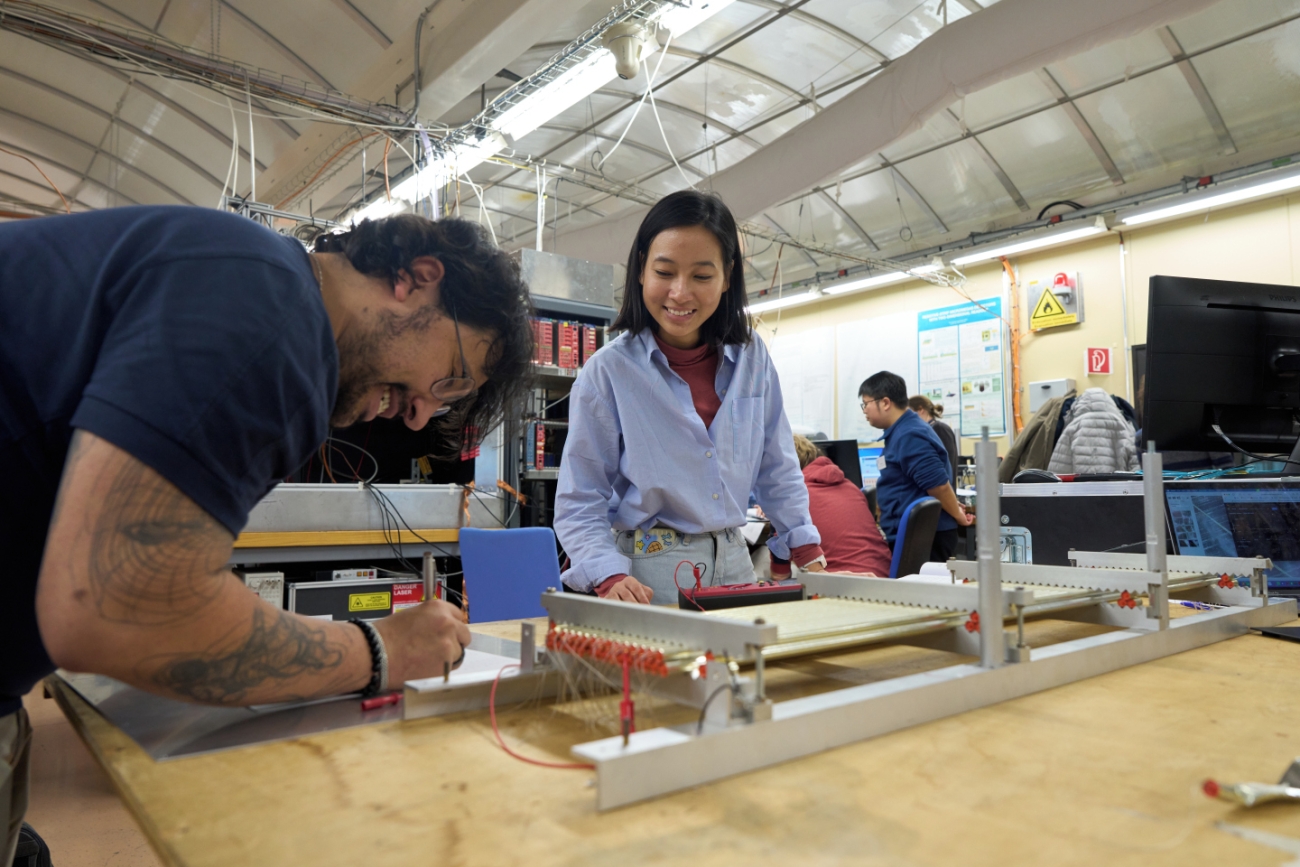Theory and practice join at the DRD1 Gaseous Detectors School

How do wire-based detectors compare to Resistive Plate Chambers? What are the performances of MicroPattern Gaseous Detectors? Which gas mixtures should be chosen for optimised operation? How will detectors face the challenges of future, more powerful accelerators?
32 students learned about these and many other aspects of gaseous detector technologies in the first DRD1 Gaseous Detectors School held at CERN last November. The program hosted by the EP-DT Gas Detectors Development (GDD) lab offered a total of 21 hours of academic lectures and nine hands-on laboratory exercises, each lasting a full afternoon. Students could assemble their own detectors, learning about specific details of importance for Resistive Plate Chambers, wire-based detectors and MicroPattern Gaseous Detectors. Following assembly laboratories, advanced lab exercises focused on optimising detectors’ performances, as well as explore radiation imaging methods including optical and electronic readout. In addition, two simulation and modelling exercises demonstrated the possibilities that state-of-the-art simulation tools offer to understanding detector operating principles and gas detector physics.
Over 40 distinguished lecturers and tutors from CERN and DRD1 member institutes, including renowned scientists, pioneers of innovative technologies, and emerging young experts, have been engaged in the school to offer a unique program and valuable insights.
Group photo of attendees of DRD1 Gaseous Detector School. The 2024 edition brought together 32 participants, including PhD students and young scientists working on gaseous detectors and now entering the field. (Image: CERN, Credits: Marina Cavazza)
Students from diverse backgrounds and levels participated in the school, ranging from Master students entering the field, PhD students working on gas detector related projects and young Postdocs. While most students were already involved in the field of gaseous detector development in research groups participating in DRD1, some used the school as an entry point to gaseous detector R&D as they were beginning to work on new projects.
As a new R&D cluster focused on gaseous detectors, the DRD1 collaboration aims at developing gaseous detector technologies in a world-wide collaborative framework of more than 170 institutes. DRD1 focuses on knowledge sharing and scientific exchange in addition to the development of novel gaseous detector technologies to address the needs of future experiments. In its first year, the collaboration initiated this instrumentation school which marks the start of a series of regular training events for young researchers. In addition, these schools also serve to exchange ideas and approaches between different research groups and encourage synergies and opportunities for collaborative developments.
Students and tutor during lab activities. The school focuses on state-of-the-art gaseous detector technologies including MPGDs, (M)RPCs and wire-based detectors. (Image: CERN, Credits: Marina Cavazza)
Throughout the ten-day long program, students did not only hear from world-experts on gaseous detectors about the most challenging aspects of future developments, but they also had the chance to discuss with lecturers and tutors their own research in a poster session. In addition, visits the Antiproton Decelerator (AD), ATLAS Visitor Center (AVC) and the SynchroCyclotron (SC) were organised to explore some of the laboratory’s historical and current research. In addition to the students following the full program of the school, the academic lectures were accessible to the full DRD1 community, with more than one hundred colleagues following in-person at CERN or remotely.

Attendees of DRD1 Gaseous Detector School had the chance to participate in hands-on activities during the afternoon sessions. (Image: CERN, Credits: Marina Cavazza)
With this detector school, the DRD1 collaboration continues in the footsteps of a similar school organised by the RD51 collaboration with an extended scope aiming at a comprehensive coverage of important topics in the development of gaseous detectors. By extending the school program to all gaseous detector technologies including MicroPattern Gaseous Detectors, Resistive Plate Chambers and wire-based detectors, the school could highlight the common aspects of development needs and techniques for the different technologies. Thus, in addition to the students, also tutors and lecturers contributing to the school program benefited from fruitful exchanges and discussions and could gain unique insights beyond their own R&D focus.
A Q&A session with CERN Director for Research and Computing Joachim Mnich was organised and students could get insights into future research directions in the field of gaseous detectors and beyond as well as a unique view on CERN’s activities.
By recognising the importance of training the future generation of researchers and transmitting the knowledge and skills that led to the successful application of gaseous detector technologies in current experiments, the DRD1 collaboration establishes a solid foundation for future detector experts. The school will take place annually, with future editions hosted at different DRD1 member institutes to highlight the global reach of the collaboration and optimally reach students from different regions and communities.
The official page of the school is: DRD1 Gaseous Detectors School 2025
Looking ahead, the 2025 edition of the school has already been officially announced. It will take place from September 17 to 24, 2025, at the FTD at Bonn University, Germany. Follow the above link for more details and registration information!



